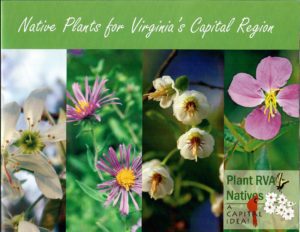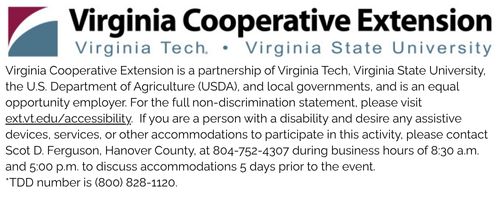 What’s All the Buzz About Natives?
What’s All the Buzz About Natives?
I had never considered the important role that native plants play in our surroundings. However, in preparation for a Master Gardener presentation, I quickly discovered my ignorance regarding this fundamental aspect of gardening. In fact, I learned that by incorporating native plants you can reduce your time and effort in your landscape. Established natives require less water, less fertilizer, and less pesticides. But more importantly, they help bolster the environment where they are placed.
In order to better understand this article, it is important to define three terms: Ecosystem, food web, and biodiversity. An ecosystem is all the living and nonliving things in the environment and all their interrelationships in a particular unit of space. A food web – describes the complex ways that things eat each other and are eaten. For example, a rabbit eats grass and a hawk eats the rabbit. Biodiversity – means that there are many plant and animal species in an environment.
A native plant is a species that occurs in a geographic region where it has evolved over thousands of years. It is uniquely adapted in response to characteristics of that area including climate, rainfall, drought, temperature, soil, and other species inhabiting that area. U.S. natives are also defined as the plants that existed in this country prior to European settlement. There are tens of thousands of plant species throughout our country that vary based on geographic regions.
Native plants help bolster the ecosystem. Over time, they have formed complex and interdependent relationships with many animals, including insects. Regardless of our feelings toward insects, they are fundamental to the transfer of energy from plants to other animals. For example, caterpillars (an insect) provide food for birds. The loss of a species can ultimately alter an entire ecosystem. Therefore, native plants are essential to the survival of many animals and our precious pollinators.
Plants from other regions, countries, or continents are called:
- Non-natives
- Exotics
- Introduced
- Aliens
In this article I will refer to non-native plants as aliens. The U.S. imports hundreds of thousands of plants every year. A native plant from one area of the country is considered an alien and may not thrive when transplanted in another area.
For instance, the Colorado Blue Spruce that is indigenous to that state, does not adapt well to the environmental conditions in Richmond, VA. In contrast to natives, alien plants do not typically support the food web. Certain imported ornamental plants are advertised as ‘Pest Free’ since many native insects are either not attracted to or not physically designed to eat those plants. This has a detrimental effect on biodiversity. Alien plants, like our turf lawns, offer low biodiversity and minimal habitat options for native wildlife.
Alien plants, which have been intentionally imported as ornamentals in the horticultural trade, have introduced devastating and unintentional consequences.
Examples include:
- Harmful plant diseases (Dutch elm disease)
- Alien insects (Japanese Beetles) without natural predators
- Invasive plants (Kudzu) lacking checks and balances
Many alien plants escaped cultivation, and some became an invasive threat and caused billions of dollars in damage nationwide annually. However, there are native plants like poison ivy that are an invasive threat as well. Not all alien plant species are harmful to our ecosystem, but they are installed into our communities at an alarming rate. They often possess a competitive edge over natives due to their more rapid and widespread growth. So, what can we do to stop this movement in our communities? Where can we learn how to replace some aliens with native plants instead?
In Virginia, there are regional campaigns and partnerships to promote the benefits of natives. “Plant Virginia Natives – Virginia Native Plant Marketing Partnership” is one such campaign. It is an effort to educate growers, landscape designers, developers, HOAs, and the public. They strive to change the misconceptions that native plants are long, leggy, unattractive, and expensive. PlantVirginiaNatives.org has designed fabulous regional guides to showcase the attractive native plants that are specific to different regions of the state.
 You can access a free, color PDF guide at https://www.plantvirginianatives.org/plant-rva-natives. Virginia Native Plant Society, Vnps.org is another informative resource for our Commonwealth. Moreover, there are great Native Plant Finder resources online that are tailored to specific locations. Fortunately, the Richmond area boasts several local nurseries that offer native plants.
You can access a free, color PDF guide at https://www.plantvirginianatives.org/plant-rva-natives. Virginia Native Plant Society, Vnps.org is another informative resource for our Commonwealth. Moreover, there are great Native Plant Finder resources online that are tailored to specific locations. Fortunately, the Richmond area boasts several local nurseries that offer native plants.
In addition to their inherent beauty, native plants offer exceptional benefits to our ecosystem such as helping to protect water quality and quantity, increasing carbon dioxide absorption from the air, reducing erosion, and improving wildlife habitats. They provide a refuge for biological diversity that consists of native organisms, plants, pollinators, birds, amphibians, and mammals. Increased plant diversity in suburban landscapes helps keep pests in check and results in less need for pesticides. Native plants are naturally adapted to an area; when well established, they require less watering and fertilization.
Implementing native gardening is one aspect of promoting sustainability which is the quality of not being harmful to the environment or depleting natural resources, and thereby supporting long-term ecological balance. A goal would be to incorporate at least 75% natives into our home landscapes. Although this is a daunting percentage, perhaps we can replace our dying aliens with native plants instead of with another alien plant. When I walk around my neighborhood, it is apparent that the developer incorporated many alien plants, many of which are dying. For instance, the Crytomeria japonicas need replacing throughout my community. Would well-suited native plants have been a better option? As home gardeners, we have great potential to counteract the environmental damage that has occurred around us by selecting native plants.
So, “What’s All the Buzz About Natives?” Native plants nurture our local pollinators consisting of bees, butterflies and hummingbirds. They have evolved with native critters for thousands of years and are an integral part of the food web. We have allowed alien plants to rob native plants of their natural homes that were designed uniquely just for them. Without the presence of native plants in our communities, the future of biodiversity is tenuous as wildlife habitats continue to decrease. We can aim to reverse this trend by adding native plants into our own backyards, which will support the natural ecosystem. From now on I am going to ‘plant smart’ by selecting natives that are well suited to my yard’s conditions.
By choosing native plants, I can reduce both time and money spent on watering, fertilizing, and stop all pesticide use. I look forward to a brighter future of gardening in my yard that consists of enjoying the native plants and critters that were meant to be there.
Dianne Hentzen
Reference List
Bringing Nature Home by Douglas W. Tallamy
Dictionary.com
Flora of Virginia App (Smartphone)
Flora of Virginia Project
https://floraofvirginia.org/flora-app/
Master Gardeners Of Northern Virginia Newsletter
https://mgnv.org/reading-room/making-your-yard-sustainable/
Missouri Botanic Garden
http://www.missouribotanicalgarden.org
Our Wildlife Habitat Garden (Stewardship Garden)
http://www.ourhabitatgarden.org/plants/natives.html
Plant Virginia Natives
https://www.plantvirginianatives.org/learn-more/#
TreePeople Blog
https://blog.treepeople.org/post/neighborhood
US Botanic Garden
http://www.usbg.gov
Virginia Department of Conservation and Recreation
http://www.dcr.virginia.gov/natural-heritage/nativeplants
Virginia Department of Environmental Quality
https://www.deq.virginia.gov/Programs/CoastalZoneManagement/CZMIssuesInitiatives/NativePlants.aspx
Virginia Native Plant Society
https://vnps.org
 Selecting Native Shrubs: Unsung Heroes for Wildlife
Selecting Native Shrubs: Unsung Heroes for Wildlife
Native shrubs are like the unsung heroes of our landscapes. They bridge the gap between the low-lying perennials and ground cover, and the towering tree canopy.
These shrubs are super important for both our resident and migratory birds, especially around the edges of fragmented forests and places where larger trees just won’t fit.

 What’s All the Buzz About Natives?
What’s All the Buzz About Natives?
